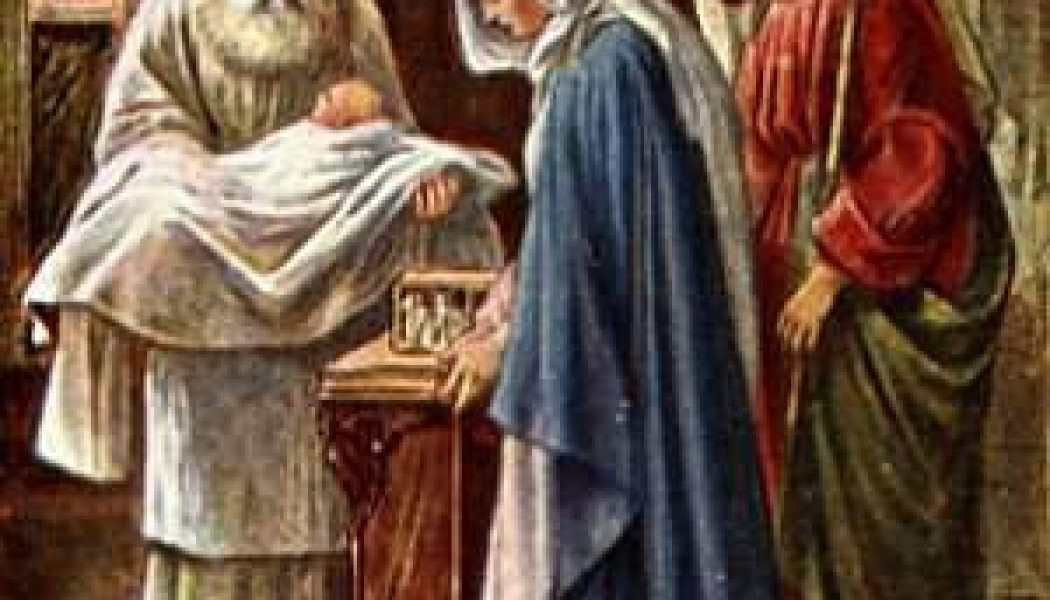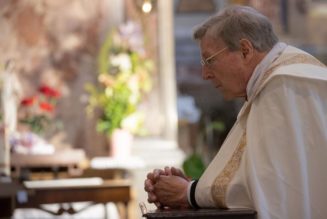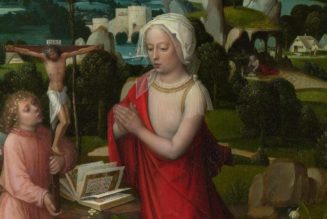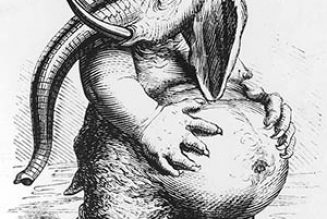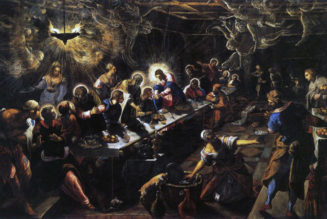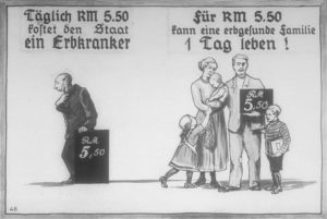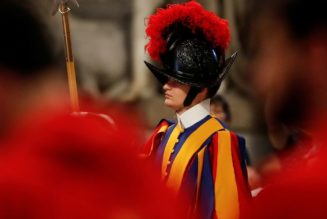have a truly unusual situation this Sunday.
Under normal circumstances, it would be the Fourth Sunday in Ordinary
Time, but it just so happens that this year, the Feast of the Presentation
(pegged to Feb. 2) falls on the Sunday and “outranks” the regular Lord’s Day
obligation. The result is that many
persons who do not regularly attend daily mass will have the rare experience of
celebrating the full liturgy for the Feast of the Presentation.
Readings for this Feast Day focus on the theme of the priesthood of Christ,
seeing a kind of sacerdotal significance to this first entrance of the Messiah
into the Temple. These Readings prompt
us to meditate firstly on how Jesus has served and continues to serve as our
great High Priest, but also how his priesthood is lived out in our own lives,
since we share in his priesthood by virtue of our Baptism.
Lo, I am sending my messenger
to prepare the way before me;
And suddenly there will come to the temple
the LORD whom you seek,
And the messenger of the covenant whom you desire.
Yes, he is coming, says the LORD of hosts.
But who will endure the day of his coming?
And who can stand when he appears?
For he is like the refiner’s fire,
or like the fuller’s lye.
He will sit refining and purifying silver,
and he will purify the sons of Levi,
Refining them like gold or like silver
that they may offer due sacrifice to the LORD.
Then the sacrifice of Judah and Jerusalem
will please the LORD,
as in the days of old, as in years gone by.
the last of the Twelve, the Book of Malachi occupies a decisive position in
shaping the interpretation the minor prophets.
Writing sometime between the ministries of Haggai and Zechariah (late
500s BC) and the reforms of Nehemiah (c 444 BC), Malachi was remembered in the
Jewish and Christian traditions as the last of the classical writing prophets
of the Old Covenant, and thus the one to give the final divine instructions to
Israel as she awaited the “Day of the LORD” and the coming of the Messiah.
is little doubt that the Book of Malachi was written during Judah’s “Persian
Period” (537–334 BC). The Second Temple
seems to be reconstructed and functioning (Mal 1:6–2:9), which would place the
ministry of Malachi after Haggai and Zechariah (i.e. 520>On the other hand, there is no mention of
Nehemiah (c. 444-420 BC), and his reforms seem not to have been implemented yet,
because mixed marriages with Gentiles (among other issues) are still a pressing
problem (Mal 2:11; cf. Neh 13).
Therefore, Malachi is almost universally dated within 500-450 BC. Those who are impressed with Malachi’s
similarity in language and concepts with Haggai-Zechariah tend to date the book
toward 500 BC, while those who place more weight on the similarity of social
pathologies addressed in Malachi and Nehemiah tend toward 450 BC.
is the case with some others of the Twelve (Joel, Obadiah, Habakkuk), the
superscription of Malachi provides no other information about the prophet other
than his name. Moreover, since “malachi”
means “my messenger” in Hebrew, it is not clear whether it is a personal name
or a title. The Septuagint, for example,
translates the superscription: “The oracle of the word of the Lord to Israel by
the hand of his angelos (=”angel” or
“messenger”)” (Mal 1:1 LXX). Therefore,
some believe the book is anonymous, and “Malachi” is simply a title given to an
unknown prophet. St. Jerome endorsed a
minor Jewish tradition that the unknown “messenger” was Ezra, but other minor
Jewish traditions identified him with Zerubbabel or Nehemiah. In more recent times, some scholars have
proposed that Malachi was once the third of three sets of anonymous “oracles” (massā’) appended to the end of
Zechariah: (1) Zech 9-11; (2) Zech 13-14, and (3) Mal 1-4. According to this hypothesis, scribes later
separated Malachi and made it an independent book in order to produce the round
number of twelve minor prophets.
However, there is no textual evidence for this theory, and the literary
character of Malachi—with its unique dialogues between God, the prophet, and
the people—is singular and quite unlike anything in Zechariah.
main stream of Jewish and Christian interpretation has understood “Malachi” as
the name of the prophetic author, whether a given name or a “pen name.” The book lends itself most naturally
understood as recording, in abbreviated form, the prophet’s dialogical
preaching and rebuke of the people of Judah (Mal 1:2–3:15) and Jerusalem in a
specific time period (c. 500-450 BC), which resulted in a communal repentance
on the part of the more religiously faithful members of the populace (Mal
3:16). Thus, it appears to be rooted in
the historical events of a prophet’s ministry, and not simply a literary
creation.
scholars have noted that Malachi seems to employ the rhetoric of the legal
court. Some have suggested that the
disputations are in the form of the covenant lawsuit or rîb, similar to Micah.
Covenant certainly is a dominating concept in Malachi, as the prophet
mentions four of them: (1) the covenant with Levi (2:4-8); (2) with “our
fathers” (2:10: Abrahamic?), (3) with one’s spouse in marriage (2:14); and (4)
the covenant associated with a divine messenger (3:1: Mosaic?). In general, we may say that the literary
dynamic of Malachi presents the prophet as the “attorney” for the LORD, who is
prosecuting Israel for various interrelated breeches of covenant.
Oracle used for this Feast Day is mysterious and intriguing. Malachi begins by saying, on behalf of God, “I
will send my messenger to prepare the way before me.” The word “messenger” can also mean “angel,”
so we could understand this as “I will send my angel before me ….” This idea of a preparatory angel recalls the
experience of Israel in the Wilderness, where the Angel of the LORD lead them
(Exod 14:19), or the conquest of the land, concerning which God promised his
angel to precede the armies of Israel (Ex 23:20,23; 32:34). The return of the Presence of the LORD will
be like those great events of salvation history, a kind of “invasion” by the
LORD. In the context of the Gospel, this
preparatory “angel” is John the Baptist, who has been dominating our thoughts
during Advent, the Feast of the Baptism, and last week’s liturgy (2nd
Week of Ordinary Time). John was the “angel”
who prepared for Jesus’ “invasion” of the Holy Land.
goes on to say, “And suddenly there will come to the temple the LORD whom you
seek, and the messenger of the covenant whom you desire ….” These verses could be understood in poetic
parallelism, such that “the LORD” and the “messenger of the covenant” are the
same person. Indeed, that is how it was
fulfilled, as Jesus was both “the LORD” (the God of Israel) and also the “messenger
of the covenant” when he entered the Temple.
Not only was he the “messenger” of the covenant, he was the
covenant (Isa 42:6; 49:8), and would give his own body and blood (i.e. his very
self) as a covenant to the Twelve in the Upper Room. A covenant is a kinship bond established by
an oath. The oath-ritual Christ will
institute for this covenant will be the eating of his body and blood.
goes on to warn his contemporaries that the arrival of the LORD in the Temple was
not just an event of consolation, but was also a portent of judgment and
purification of liturgical abuse. “Who
can endure the day of his coming? He
will purify the sons of Levi,” Malachi says.
This means: purify the priesthood of evildoers, and rectify liturgical
abuses.
was priestly corruption and liturgical abuse in Malachi’s day, as we can see
from reading his book. Israelites were offering
unfit animals in sacrifice, and the priests were permitting this to occur. Likewise, in Our Lord’s day there were
greatly priestly and liturgical abuses.
Although his visit to the Temple as an infant will not immediately
confront these abuses, his visits to the Temple as an adult certainly
would. At least two Temple cleansings
are recorded in the Gospels, one at the beginning of Jesus’ public ministry in
John 2, and one at the beginning of Jesus’ Passion Week in the other three
Gospels. Personally, I believe Jesus had
a public ministry of three or more years, and that he cleansed the Temple every
time he entered Jerusalem (because the scammers moved back in every time he
left). In Jesus’ lifetime, the High Priesthood was held by imposters without
the right blood line, and the Court of the Gentiles was defiled by being turned
into a religious bazaar for the exchange of currency and sale of sacrificial
animals.
says the LORD will “refine the sons of Levi” (i.e. the priests) so that they
may “offer due sacrifice” to the LORD.
Jesus fulfills this by establishing a new order of priests, the Twelve,
and teaching them how to offer the “due sacrifice” of the New Covenant, the
thanksgiving sacrifice we call the Eucharist.
After showing them how to celebrate it, Jesus commissions the Twelve as
new priests to replace the Levitical priests when he says, “Do this as my
memorial [sacrifice]”. The entrance of the LORD into the Temple at the Presentation
announces the beginning of a process that will culminate in the establishment
of a New Temple (the mystical Body of Christ), a new Liturgy (the Eucharist and
the other sacraments and their rites), and a new Priesthood (the apostles and
those who succeed them) in the Upper Room.
R.
(8) Who is this king of glory? It is the Lord!
Lift up, O gates, your lintels;
reach up, you ancient portals,
that the king of glory may come in!
R. Who is this king of glory? It is the Lord!
Who is this king of glory?
The LORD, strong and mighty,
the LORD, mighty in battle.
R. Who is this king of glory? It is the Lord!
Lift up, O gates, your lintels;
reach up, you ancient portals,
that the king of glory may come in!
R. Who is this king of glory? It is the Lord!
Who is this king of glory?
The LORD of hosts; he is the king of glory.
R. Who is this king of glory? It is the Lord!
24 reflects an ancient procession ritual practiced in the Jerusalem Temple, the
rubrics of which were never recorded. I
suspect that, very early in Israel’s history, the Ark of the Covenant was
periodically removed from the Holy of Holies by the Levites and re-processed
into the Holy City in a ceremony celebrating God’s kingship. Or, perhaps this
Psalm reflects the time before the building of the Temple, when the Ark will
periodically relocate to a new city in Israel, and be welcomed by the new host
city. The line about “the LORD mighty in
battle” may recall times when the Ark of the Covenant would accompany Israel’s
troops in warfare and return triumphantly.
Regardless, in the context of the Feast of the Presentation, we have
both the New Ark (Mary) and the LORD Himself (Jesus) entering the Temple. The idea of the lintels and the gates rising
up to allow the “King of Glory” to enter is poetic hyperbole. Sometimes in the ancient world, the imperial
pallaquin of a great king was too large for the gates of the city which he was
coming to visit, so the gates literally had to be dismantled and raised. The concept of majesty is being described as
extension in space. Although Jesus is
very small physically, his majesty cannot be contained by the Temple
gates. If Jesus’ glory was manifested in
some physical form, it would be more than the earthly Temple could
accommodate. Moreover, Jesus enters as “the
LORD mighty in battle,” invading the Promised Land—and indeed the earth itself—with
his divine presence, preparing to do battle against sin, death, and the Devil,
defeating them all on one day in Jerusalem 33 years later.
the children share in blood and flesh,
Jesus likewise shared in them,
that through death he might destroy the one
who has the power of death, that is, the Devil,
and free those who through fear of death
had been subject to slavery all their life.
Surely he did not help angels
but rather the descendants of Abraham;
therefore, he had to become like his brothers and sisters
in every way,
that he might be a merciful and faithful high priest before God
to expiate the sins of the people.
Because he himself was tested through what he suffered,
he is able to help those who are being tested.
many of the themes from the First Reading and the Psalm continue into this
reflection on Christ’s priesthood in the Epistle to the Hebrews. The concept of Christ-as-Warrior is present
here when Paul speaks of Jesus “destroying the one who has the power of death”
and freeing those he has enslaved. We
also see Jesus “becoming like his brothers and sisters in every way,” as he,
like any other male child born into an Israelite family, undergoes the
ceremonial rituals that Moses prescribed for a sinful people—rituals from which
he and his mother were should have been exempt, yet they humble themselves to
submit to them. Yet the humility of
Jesus’ life of obedience under the Law of Moses—a Law given to a people who
were hard of heart—prepared him to be a fitting High Priest for the New
Covenant people. He who submitted to
animal sacrifices for his purification, would one day make his own body the ultimate
sacrifice, purifying stains of sin no animal blood could expunge.
Finally, our Gospel is Lk 2:22-40:
purification
according to the law of Moses,
Mary and Joseph took Jesus up to Jerusalem
to present him to the Lord,
just as it is written in the law of the Lord,
Every male that opens the womb shall be
consecrated to the Lord,
and to offer the sacrifice of
a pair of turtledoves or two young pigeons,
in accordance with the dictate in the law of the Lord.
is at pains to emphasize that the Holy Family was obedient to the law in
humility, although they could have claimed special exemption from its
demands. This sets an example for
us. No Christian, no matter how gifted
with charisms or elevated in clerical position, should ever think he is “above
the law” of God. Recent and continuing
scandals have been the result of men thinking this, that their special status excused
violations of the law or permitted them to indulge themselves in ways not
lawful for other Christians. But this is
not the case. No Christian, from the
newly baptized infant to the Pope, is excused from the moral law or the proper
rules for the celebration of the sacraments.
No one should take liberties with the laws of faith and morals or canon
law in order to favor a person who holds some special status.
also demonstrates here that he is a man of order and authority, not a rebel
anarchist trying to destabilize the social or ecclesiastical order. Although Jesus’ teaching can and does
destabilize illegitimate systems of authority, it is not for the sake of
anarchy but for the establishment of the order of Christ’s kingdom, governed by
the Apostles and those who have received the succession of the priesthood from
them.
male that opens the womb shall be consecrated to the LORD,”—this line reminds
us of the original priesthood of Israel, in which the firstborn of every family
was consecrated for priestly service. This
took place in the first Passover, through which all the firstborn of Israel
were consecrated to God. “Consecration” in the Old Testament, in the context of
a male human being, is usually a synonym for “ordination to priestly service.” Jewish tradition, based on Scripture, is that
the firstborn of Israel served as priests before being replaced by the Levites after
the Golden Calf debacle. Jesus is not
from the tribe of Levi. He is from the
tribe of Judah, the patriarch to whom the rights of the firstborn fell after
the cursing of his three older brothers.
Jesus, as firstborn of the royal family of the House of Judah, is a kind
of firstborn of the people of Israel, and he will reclaim “the priesthood of
the firstborn” lost at the Golden Calf.
scholars note that nothing is said of Jesus’ “redemption” sacrifice in this
episode. Non-Levite Israelite firstborns
were required to be redeemed, that is, “bought back” from God at the price of
an animal sacrifice, and their natural place serving God in the sanctuary was
filled by a Levite. Nothing is said of
Jesus’ redemption sacrifice—just as nothing is said of Samuel’s in the Old
Testament (1 Sam 1-3), because Samuel was not redeemed but left at the Temple
to serve. (Interestingly, the story
after the Presentation is one in which Jesus is left behind to serve in the
Temple similar to Samuel of old, and Jesus is confused as to why Joseph and
Mary return to get him ….) Is this because Jesus was not redeemed, or simply an
oversight on Luke’s part? (The sacrifice of turtledoves mentioned is actually
for the purification of the mother from ritual uncleanness, not for the
redemption of the child.) We can’t know, but it does point toward the priestly
status that Jesus enjoys.
name was Simeon.
This man was righteous and devout,
awaiting the consolation of Israel,
and the Holy Spirit was upon him.
It had been revealed to him by the Holy Spirit
that he should not see death
before he had seen the Christ of the Lord.
He came in the Spirit into the temple;
and when the parents brought in the child Jesus
to perform the custom of the law in regard to him,
he took him into his arms and blessed God, saying:
go
in peace, according to your word,
for my eyes have seen your salvation,
which you prepared in the sight of all the peoples:
a light for revelation to the Gentiles,
and glory for your people Israel.”
amazed at what was said about him;
and Simeon blessed them and said to Mary his mother,
“Behold, this child is destined
for the fall and rise of many in Israel,
and to be a sign that will be contradicted
–and you yourself a sword will pierce–
so that the thoughts of many hearts may be revealed.”
There was also a prophetess, Anna,
the daughter of Phanuel, of the tribe of Asher.
She was advanced in years,
having lived seven years with her husband after her marriage,
and then as a widow until she was eighty-four.
She never left the temple,
but worshiped night and day with fasting and prayer.
And coming forward at that very time,
she gave thanks to God and spoke about the child
to all who were awaiting the redemption of Jerusalem.
prescriptions
of the law of the Lord,
they returned to Galilee, to their own town of Nazareth.
The child grew and became strong, filled with wisdom;
and the favor of God was upon him.
is recognized as a child marked by God for the fulfillment of sacred promises
by the community of devout Israelites awaiting the fulfillment of the prophetic
promises. This community included groups
like the Essenes, a holiness reform movement, but was not limited to them.
Simeon comes forward and speaks of the child in language that is redolent of
the diction of the prophet Isaiah— a light for revelation to the Gentiles, and
glory for your people Israel—this is typically Isaianic, emphasizing that
the salvation brought by the Messiah would not be limited to the Jews, but for
all Israel and all nations. The
priesthood and liturgy that Jesus would establish would not be ethnic and would
spread to all the nations of the earth.
Simeon speaks to the Blessed Mother: “a sword will pierce your own soul,”
indicating her co-passion with her divine son and her extraordinary
co-redeeming role, replicating in each one of us in a less singular
manner. Everyone attached to Christ will
experience his cross, and as a lance pierced his heart, a “sword” will pierce
each one of us, an interior agony caused by the love of God flowing through us
being rejected by the world around us.
And so we are reminded that the priesthood of Christ, foreshadowed by
his entrance into the Temple as a child, necessarily involves suffering and
self-immolation, since he is not just priest but also victim. We share these roles as his mystical
body. On this Feast of the Presentation,
let’s plead with Christ for more of his strength through the Holy Spirit to be
communicated to us, that we may endure the sufferings of this present life as
we share in his atoning priesthood for the sake of the salvation of all the
nations.
<!– /* Font Definitions */
@font-face {font-family:"Cambria Math"; panose-1:2 4 5 3 5 4 6 3 2 4; mso-font-charset:0; mso-generic-font-family:roman; mso-font-pitch:variable; mso-font-signature:-536870145 1107305727 0 0 415 0;}
@font-face {font-family:Calibri; panose-1:2 15 5 2 2 2 4 3 2 4; mso-font-charset:0; mso-generic-font-family:swiss; mso-font-pitch:variable; mso-font-signature:-536870145 1073786111 1 0 415 0;}
@font-face {font-family:Cambria; panose-1:2 4 5 3 5 4 6 3 2 4; mso-font-charset:0; mso-generic-font-family:roman; mso-font-pitch:variable; mso-font-signature:-536870145 1073743103 0 0 415 0;} /* Style Definitions */
p.MsoNormal, li.MsoNormal, div.MsoNormal {mso-style-unhide:no; mso-style-qformat:yes; mso-style-parent:""; margin:0in; margin-bottom:.0001pt; mso-pagination:widow-orphan; font-size:12.0pt; font-family:"Calibri",sans-serif; mso-ascii-font-family:Calibri; mso-ascii-theme-font:minor-latin; mso-fareast-font-family:Calibri; mso-fareast-theme-font:minor-latin; mso-hansi-font-family:Calibri; mso-hansi-theme-font:minor-latin; mso-bidi-font-family:"Times New Roman"; mso-bidi-theme-font:minor-bidi;}
.MsoChpDefault {mso-style-type:export-only; mso-default-props:yes; font-family:"Calibri",sans-serif; mso-ascii-font-family:Calibri; mso-ascii-theme-font:minor-latin; mso-fareast-font-family:Calibri; mso-fareast-theme-font:minor-latin; mso-hansi-font-family:Calibri; mso-hansi-theme-font:minor-latin; mso-bidi-font-family:"Times New Roman"; mso-bidi-theme-font:minor-bidi;}size:8.5in 11.0in; margin:1.0in 1.0in 1.0in 1.0in; mso-header-margin:.5in; mso-footer-margin:.5in; mso-paper-source:0;}
div.WordSection1 {page:WordSection1;}
